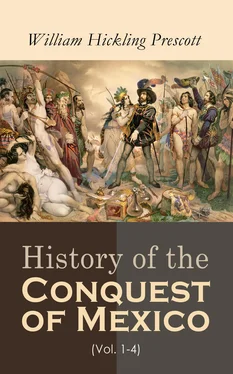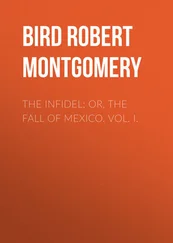Some few of these maps have interpretations annexed to them, which were obtained from the natives after the Conquest. [166]The greater part are without any, and cannot now be unriddled. Had the Mexicans made free use of a phonetic alphabet, it might have been originally easy, by mastering the comparatively few signs employed in this kind of communication, to have got a permanent key to the whole. [167]A brief inscription has furnished a clue to the vast labyrinth of Egyptian hieroglyphics. But the Aztec characters, representing individuals, or, at most, species, require to be made out separately; a hopeless task, for which little aid is to be expected from the vague and general tenor of the few interpretations now existing. There was, as already mentioned, until late in the last century, a professor in the University of Mexico, especially devoted to the study of the national picture-writing. But, as this was with a view to legal proceedings, his information, probably, was limited to deciphering titles. In less than a hundred years after the Conquest, the knowledge of the hieroglyphics had so far declined that a diligent Tezcucan writer complains he could find in the country only two persons, both very aged, at all competent to interpret them. [168]
It is not probable, therefore, that the art of reading these picture-writings will ever be recovered; a circumstance certainly to be regretted. Not that the records of a semi-civilized people would be likely to contain any new truth or discovery important to human comfort or progress; but they could scarcely fail to throw some additional light on the previous history of the nation, and that of the more polished people who before occupied the country. [169]This would be still more probable, if any literary relics of their Toltec predecessors were preserved; and, if report be true, an important compilation from this source was extant at the time of the invasion, and may have perhaps contributed to swell the holocaust of Zumárraga. [170]It is no great stretch of fancy to suppose that such records might reveal the successive links in the mighty chain of migration of the primitive races, and, by carrying us back to the seat of their possessions in the Old World, have solved the mystery which has so long perplexed the learned, in regard to the settlement and civilization of the New. [171]
Besides the hieroglyphical maps, the traditions of the country were embodied in the songs and hymns, which, as already mentioned, were carefully taught in the public schools. These were various, embracing the mythic legends of a heroic age, the warlike achievements of their own, or the softer tales of love and pleasure. [172]Many of them were composed by scholars and persons of rank, and are cited as affording the most authentic record of events. [173]The Mexican dialect was rich and expressive, though inferior to the Tezcucan, the most polished of the idioms of Anahuac. None of the Aztec compositions have survived, but we can form some estimate of the general state of poetic culture from the odes which have come down to us from the royal house of Tezcuco. [174]Sahagun has furnished us with translations of their more elaborate prose, consisting of prayers and public discourses, which give a favorable idea of their eloquence, and show that they paid much attention to rhetorical effect. They are said to have had, also, something like theatrical exhibitions, of a pantomimic sort, in which the faces of the performers were covered with masks, and the figures of birds or animals were frequently represented; an imitation to which they may have been led by the familiar delineation of such objects in their hieroglyphics. [175]In all this we see the dawning of a literary culture, surpassed, however, by their attainments in the severer walks of mathematical science.
They devised a system of notation in their arithmetic sufficiently simple. The first twenty numbers were expressed by a corresponding number of dots. The first five had specific names; after which they were represented by combining the fifth with one of the four preceding; as five and one for six, five and two for seven, and so on. Ten and fifteen had each a separate name, which was also combined with the first four, to express a higher quantity. These four, therefore, were the radical characters of their oral arithmetic, in the same manner as they were of the written with the ancient Romans; a more simple arrangement, probably, than any existing among Europeans. [176]Twenty was expressed by a separate hieroglyphic,—a flag. Larger sums were reckoned by twenties, and, in writing, by repeating the number of flags. The square of twenty, four hundred, had a separate sign, that of a plume, and so had the cube of twenty, or eight thousand, which was denoted by a purse, or sack. This was the whole arithmetical apparatus of the Mexicans, by the combination of which they were enabled to indicate any quantity. For greater expedition, they used to denote fractions of the larger sums by drawing only a part of the object. Thus, half or three-fourths of a plume, or of a purse, represented that proportion of their respective sums, and so on. [177]With all this, the machinery will appear very awkward to us, who perform our operations with so much ease by means of the Arabic or, rather, Indian ciphers. It is not much more awkward, however, than the system pursued by the great mathematicians of antiquity, unacquainted with the brilliant invention, which has given a new aspect to mathematical science, of determining the value, in a great measure, by the relative position of the figures.
In the measurement of time, the Aztecs adjusted their civil year by the solar. They divided it into eighteen months of twenty days each. Both months and days were expressed by peculiar hieroglyphics,—those of the former often intimating the season of the year, like the French months at the period of the Revolution. Five complementary days, as in Egypt, [178]were added, to make up the full number of three hundred and sixty-five. They belonged to no month, and were regarded as peculiarly unlucky. A month was divided into four weeks, of five days each, on the last of which was the public fair, or market-day. [179]This arrangement, differing from that of the nations of the Old Continent, whether of Europe or Asia, [180]has the advantage of giving an equal number of days to each month, and of comprehending entire weeks, without a fraction, both in the months and in the year. [181]
As the year is composed of nearly six hours more than three hundred and sixty-five days, there still remained an excess, which, like other nations who have framed a calendar, they provided for by intercalation; not, indeed, every fourth year, as the Europeans, [182]but at longer intervals, like some of the Asiatics. [183]They waited till the expiration of fifty-two vague years, when they interposed thirteen days, or rather twelve and a half, this being the number which had fallen in arrear. Had they inserted thirteen, it would have been too much, since the annual excess over three hundred and sixty-five is about eleven minutes less than six hours. But, as their calendar at the time of the Conquest was found to correspond with the European (making allowance for the subsequent Gregorian reform), they would seem to have adopted the shorter period of twelve days and a half, [184]which brought them, within an almost inappreciable fraction, to the exact length of the tropical year, as established by the most accurate observations. [185]Indeed, the intercalation of twenty-five days in every hundred and four years shows a nicer adjustment of civil to solar time than is presented by any European calendar; since more than five centuries must elapse before the loss of an entire day. [186]Such was the astonishing precision displayed by the Aztecs, or, perhaps, by their more polished Toltec predecessors, in these computations, so difficult as to have baffled, till a comparatively recent period, the most enlightened nations of Christendom! [187]
Читать дальше












